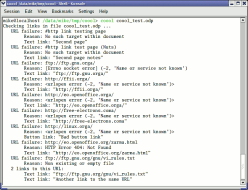Add an introduction sequence to a Theora video
Introduction
For the needs of producing conference videos, we developed a Python script to add an introduction sequence to a given Ogg/Theora video:
Usage: theora-intro [options] input-video title-image output-video
Adds an introduction to a source Ogg/Theora video, using the given title image
Options:
--version show program's version number and exit
-h, --help show this help message and exit
-v, --verbose Verbose mode
--artist=ARTIST Overrides the ARTIST Ogg metadata
--title=TITLE Overrides the TITLE Ogg metadata
--date=DATE Overrides the DATE Ogg metadata
--location=LOCATION Overrides the LOCATION Ogg metadata
--organization=ORGANIZATION
Overrides the ORGANIZATION Ogg metadata
--copyright=COPYRIGHT
Overrides the COPYRIGHT Ogg metadata
--license=LICENSE Overrides the LICENSE Ogg metadata
--contact=CONTACT Overrides the CONTACT Ogg metadata
Why was this script created?
This script was created especially for people who need to produce multiple videos, typically from the same event. So far, the only way to add an introduction video with fade-in and fade-out was through interactive video editors, such as kdenlive, and this required to encode the video again. Another reason to create a script is that the sequence of commands to run and the amount of data to extract and generate is rather complex. Having a script rather than just a howto thus reduces the risk of errors and mistakes.
Downloads
All the releases of theora-intro can be found here.
How it works
To create an introduction sequence and concatenate it to the input video, theora-intro first needs to collect information from the input video. In particular, it reads the video width, height, the number of frames per seconds, as well as the audio bitrate and sample frequency, which need to be the same in the introduction sequence.
The introduction sequence shows the input title image (scaled), which fades in from a black picture, and eventually fades out to black again. The script actually generates a series of PNG images (using ImageMagick‘s convert utility), and converts this series into a video using ffmpeg2theora. Any input image format should work (JPG, GIF, PNG…), as ImageMagick supports most existing formats.
To be complete, the introduction sequence also needs an audio track. If it didn’t, the output video wouldn’t have any. Therefore, theora-intro generates a silent sample in WAV format, and converts it to Ogg/Vorbis.
The audio and video for the introduction sequence are then merged and concatenated. For some reasons still a bit unclear, the audio tracks of the introduction and input videos need to be resampled, but at last, there is no need to encode the video again. This makes theora-intro much faster than the time it takes to encode the video (just a few minutes even for big video files encoded in several hours).
You can find out more details by reading the code! It shoudn’t be difficult to understand it.
Ogg Metadata
It is useful to produce Ogg/Theora videos with appropriate metadata (artist, title, location, copyright…). If the input video contains such metadata, these metadata are also replicated to the generated video. Note that theora-intro has options to override these metadata when needed, or when there are no such metadata in the input video.
Requirements
This script relies on several software packages and libraries:
- vorbis-tools
- ImageMagick
- ffmpeg2theora
- oggz-tools
- Ogg Video Tools, at least version 0.8.
In Ubuntu and Debian, you can get the first four packages as follows:
sudo apt-get install vorbis-tools imagemagick ffmpeg2theora oggz-tools
Anyway, if any of the above packages is missing, theora-intro will let you know.
Use in real life
theora-intro was used to produce videos from the 2009 edition of the Embedded Linux Conference.
Known issues
At the moment, videos generated with the latest release still show a few warnings with the ogginfo command:
$ ogginfo elc2009-bird-closing.ogv Processing file "elc2009-bird-closing.ogv"... New logical stream (#1, serial: 376a8b22): type theora New logical stream (#2, serial: 06fd37a7): type vorbis Theora headers parsed for stream 1, information follows... Version: 3.2.1 Vendor: Xiph.Org libTheora I 20081020 3 2 1 Width: 1280 Height: 720 Total image: 1280 by 720, crop offset (0, 0) Framerate 25/1 (25.00 fps) Aspect ratio undefined Colourspace: Rec. ITU-R BT.470-6 Systems B and G (PAL) Pixel format 4:2:0 Target bitrate: 0 kbps Nominal quality setting (0-63): 63 User comments section follows... TITLE=Tim Bird (Sony)- ELC Closing DATE=May 2009 LOCATION=San Francisco ORGANIZATION=Bootlin COPYRIGHT=Bootlin LICENSE=Creative Commons BY-SA 3.0 CONTACT=feedback@... ENCODER=ffmpeg2theora-0.23 Vorbis headers parsed for stream 2, information follows... Version: 0 Vendor: Xiph.Org libVorbis I 20070622 (1.2.0) Channels: 2 Rate: 48000 Nominal bitrate: 48.000000 kb/s Upper bitrate not set Lower bitrate not set User comments section follows... ENCODER=oggVideoTools 0.8 Warning: Expected frame 5265, got 5266 Warning: Expected frame 5270, got 5269 Warning: Expected frame 12663, got 12664 Warning: Expected frame 12667, got 12666 Warning: Expected frame 13657, got 13658 Warning: Expected frame 13660, got 13659 Warning: Expected frame 14213, got 14214 Warning: Expected frame 14218, got 14217 Warning: Expected frame 14875, got 14876 Warning: Expected frame 14879, got 14878 Warning: Expected frame 17635, got 17636 Warning: Expected frame 17638, got 17637 Vorbis stream 2: Total data length: 4322809 bytes Playback length: 11m:57.264s Average bitrate: 48.214426 kb/s Logical stream 2 ended Theora stream 1: Total data length: 49233283 bytes Playback length: 11m:57.320s Average bitrate: 549.080277 kb/s Logical stream 1 ended
These warnings don’t seem to create any issue in Ogg/Theora players. They are probably caused by an issue in the Ogg Video Tools, and we have reported this to their maintainer.




